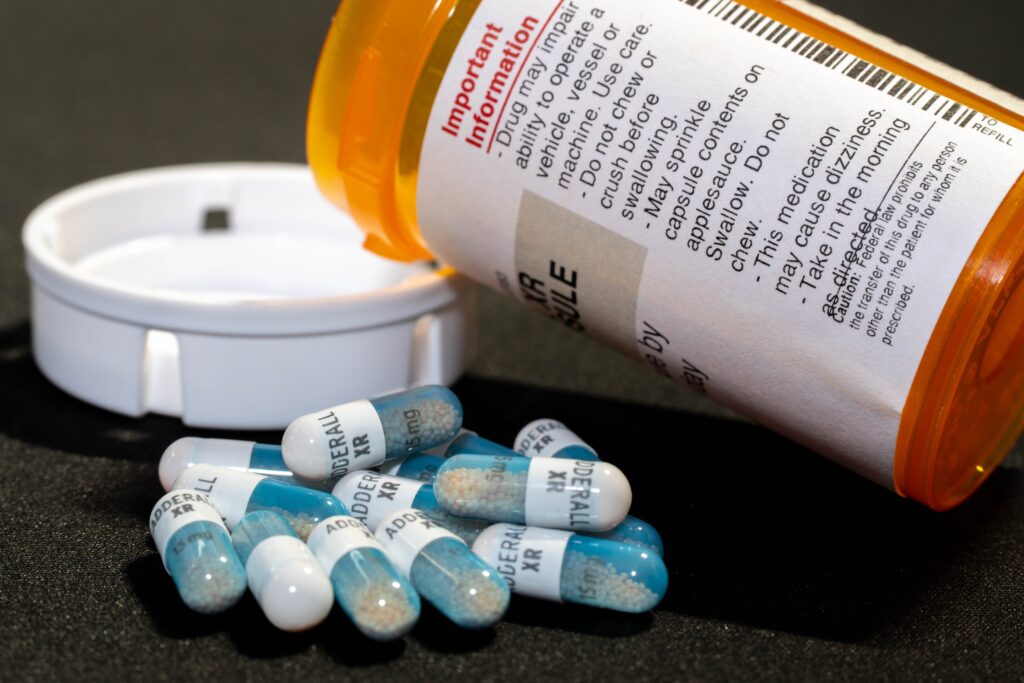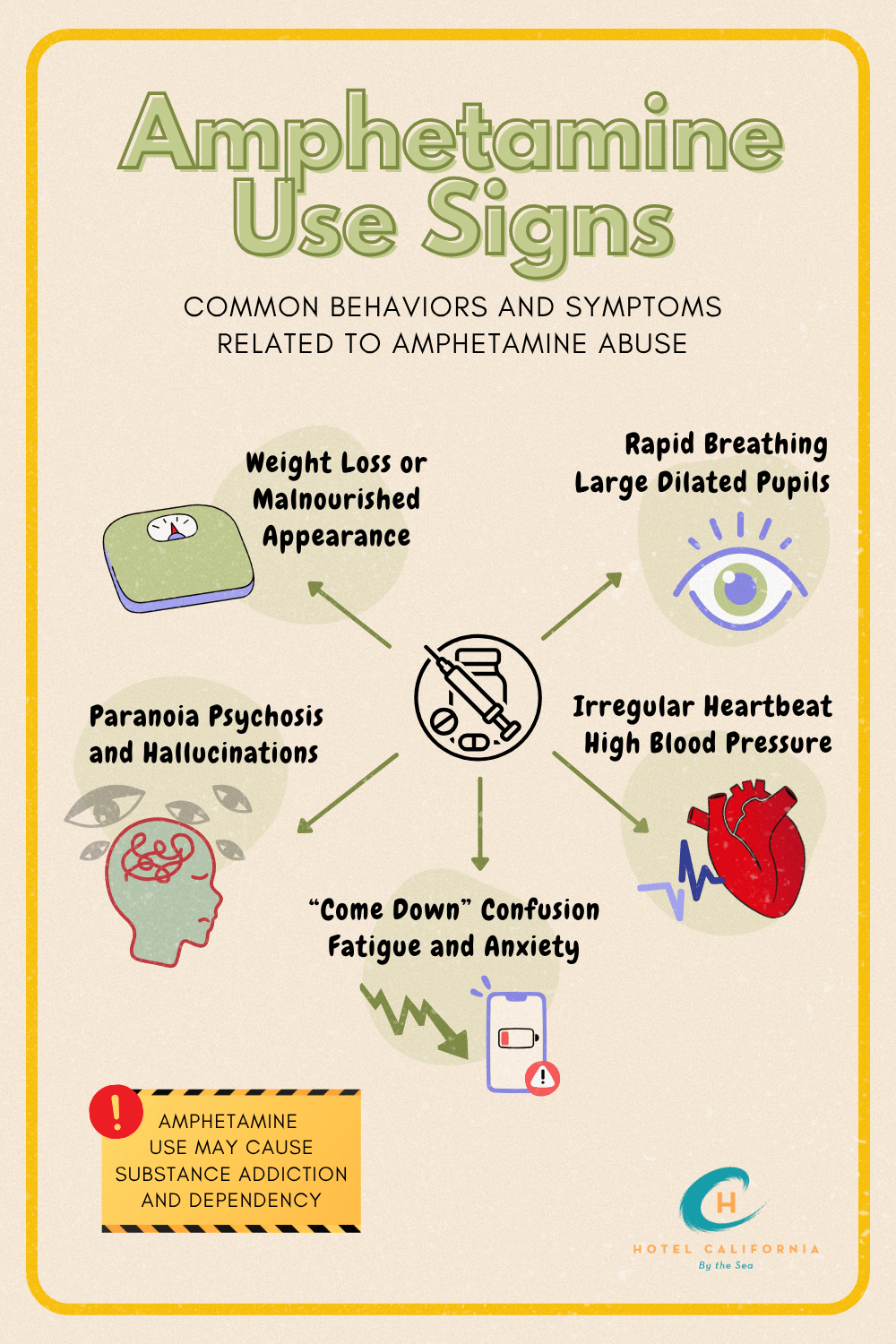Amphetamine Use Signs
Amphetamines are stimulant drugs commonly prescribed to treat conditions such as ADHD and narcolepsy. Amphetamines are often abused and used recreationally for their euphoric effects. This often leads to the development of tolerance, dependence and addiction. There are some common amphetamine use signs to look out for. These signs or symptoms can indicate a larger problem with substance use disorder.

Stimulant drugs like amphetamines increase brain chemicals in the central nervous system. They specifically stimulate the dopamine and norepinephrine neurotransmitters that can lead to feelings of alertness, increased focus, and an elevated mood. Stimulants in general, speed up the body’s entire system. Some of them are legally prescribed medications and some of them are illicitly consumed.
Amphetamines are highly potent and can easily become addictive. When using amphetamines over a long period of time, it can cause dependence to develop. Even when amphetamine medications are prescribed by a healthcare provider, such as Adderall, there is still a chance for dependency and addiction. In 2020, an estimated 5.1 million people in the US reported misusing prescription amphetamine stimulants like Adderall.
More about Amphetamines
Amphetamines were first marketed in the 1930s as the drug Benzedrine. It was an over-the-counter inhaler used to treat nasal congestion. By 1937, amphetamines became available via prescriptions in tablet form. They were used in the treatment of the sleep disorder narcolepsy.
Amphetamines can come in pill or powder form. Pure amphetamine is a white, odorless, bitter-tasting crystalline powder. Illicitly manufactured amphetamines will vary in purity and can be white with hints of gray or pink in the powder. They can be injected, smoked, snorted or taken orally as pills.
Side effects of amphetamine use can occur as soon as 30 minutes after initial ingestion. Most amphetamines remain in the central nervous system for a long period of time. A large percentage of the drug can remain in the body unchanged and produce prolonged stimulant effects.
Common side effects of amphetamine use include alertness, confidence, increased energy, talkativeness, restlessness and increased sociability. On the other hand, it can also cause more negative side effects such as aggression, hostility, fever, sweating, blurred vision, tremors, loss of coordination and headaches.
Today, many amphetamines are categorized as Schedule II controlled substances with high potential for abuse and very specific acceptations for medical use. The most common amphetamine medications include Adderall, Vyvanse, Ritalin and Concerta. Vyvanse was one of the top-selling drugs in the US in 2023, with sales of $2.5-$3 billion annually.
On the other hand, common street names for illicitly consumed amphetamines include Bennies, Black Beauties, Crank, Ice, Speed and Uppers. Methamphetamine is the most commonly abused and recreationally used type of amphetamine drug

Amphetamine Abuse Symptoms
- Irregular heartbeat
- High blood pressure
- Increased risk of heart attack or stroke
- Severe agitation or violent and erratic behavior
- Panic
- Extreme paranoia and emotional instability
- Delusions and hallucinations
- High body temperature
- Seizures
- Breakdown of muscle tissues
- Rapid weight loss or changes in appetite
- Insomnia and irregular sleep patterns
- Changes in social circles
- Becoming withdrawn from friends and family
- Neglecting responsibilities and home, work or school
- Engaging in risky behaviors to obtain or use amphetamines
- Experiencing withdrawal symptoms when drug use has stopped or significantly decreased
- Anxiety and confusion
- Psychosis that can resemble schizophrenia
- Skin picking
- Preoccupation with thoughts
- Risk of dependence
Drug Abuse vs Substance Dependency vs Substance Addiction
Drug abuse is when a person begins taking a medication in a way other than prescribed. This can include taking a medication prescribed for someone else. This can include taking the medication for the high or rush of euphoria. This can include taking the medication in a different method such as smoking or injecting. And this can also include taking the medication in higher doses than recommended.
A substance dependency is the physical symptom of tolerance and withdrawal that occurs when an addictive drug is no longer present in the body. The body has become chemically dependent to the drug, so that without it, the system will experience uncomfortable symptoms as the body rebalances itself.
An addiction is a long-term behavioral, physical and social change in a person due to drug abuse. Even when a medication is being used as prescribed, it can lead to the development of a substance addiction. A person with an addiction cannot control their use of a particular substance such as alcohol, smoking or using drugs.
Amphetamines can be abused. Amphetamines can cause substance dependency. And amphetamines can cause substance addiction.
Check Your Insurance Coverage for FREE
Find out if your insurance covers addiction treatment in minutes. We accept most insurance!
Amphetamine Addiction
Over the past years, there has been a significant increase in the misuse of psychostimulants including amphetamines. It is especially prevalent among professionals in high-pressure job industries like Wall Street and Silicon Valley. More and more people are turning to amphetamine medications to cope with demanding workloads and extended hours.
Young professionals are finding themselves resorting to taking Adderall pills to cope with extremely intense work schedules. This easily leads to increased misuse of the drug, rapid onset of effects, increased risk of dependence, burnout, depression and other negative consequences.
In a 2024 report, research found that young bankers on Wall Street were frequently using stimulants like Adderall and Vyvanse to help them manage rigorous schedules. This trend in stimulant amphetamine use has become more and more prevalent among young entry-level professionals in jobs where it’s normal to work long hours and face intense performance pressures.
In the March 2025 issues of JAMA, a National Institute of Drug Abuse researcher and his colleagues found there to be a prevalence in patterns of prescription stimulant use, misuse and drug disorders among US adults.
Stimulant prescription use, which includes amphetamines, grew an estimated 250% from 2006 to 2016, with only a minimal increase in diagnosis for ADHD. In 2020, an estimated 7% of US adults used prescription stimulants in the last year. The study indicated that there was some abuse of the drugs.
Now, recent studies estimate that about 15.5 million American adults have been diagnosed with ADHD. Some believe this number better reflects the awareness and screening of this mental illness. Others suspect an overdiagnosis for stimulant seeking and performance-enhancing drugs like amphetamines.
Who is abusing Amphetamines and why?
Who are the people who are most likely to abuse amphetamines? Young professionals who are trying to manage a hectic and heavy workload. College students who are trying to stay awake longer and study more. Athletes who want to be able to improve their performance with longer endurance and training time. Truck drivers who drive long hours often need boosts of energy. And even some people who have an eating disorder abuse amphetamines to try and lose weight.
One of the primary reasons for prescription amphetamine misuse is to enhance alertness and concentration. Some use it to assist with long study hours. Some abuse the substance to achieve a sense of high and euphoria and some use it to experiment or modify the effects of other substances.
Reach out to Hotel California by the Sea
We specialize in treating addiction and other co-occurring disorders, such as PTSD. Our Admissions specialists are available to walk you through the best options for treating your addiction.
Treatment for Substance Use Disorder
Amphetamine stimulant drugs can become very addictive. Amphetamine dependence is a type of stimulant use disorder in which users can experience withdrawal symptoms when drug use has significantly decreased or stopped. Hotel California by the Sea is a behavioral health treatment program that specializes in substance use disorders like amphetamine addiction.
We offer treatment at all levels of care including detox, residential, PHP and IOP. We utilize evidence-based methods such as CBT, DBT and EMDR therapy. Hotel California by the Sea is dedicated to helping clients understand their triggers and mental health issues to help them overcome their addiction.
References:
https://rehabsuk.com/blog/how-to-spot-the-signs-of-amphetamine-addiction
https://www.dea.gov/sites/default/files/2025-01/Amphetamines-2024-Drug-Fact-Sheet.pdf
https://www.camh.ca/en/health-info/mental-illness-and-addiction-index/amphetamines
https://www.healthline.com/health/amphetamine-dependence
https://www.medicalnewstoday.com/articles/amphetamine-addiction
https://www.psychologytoday.com/us/blog/addiction-outlook/202503/the-new-amphetamine-crisis
